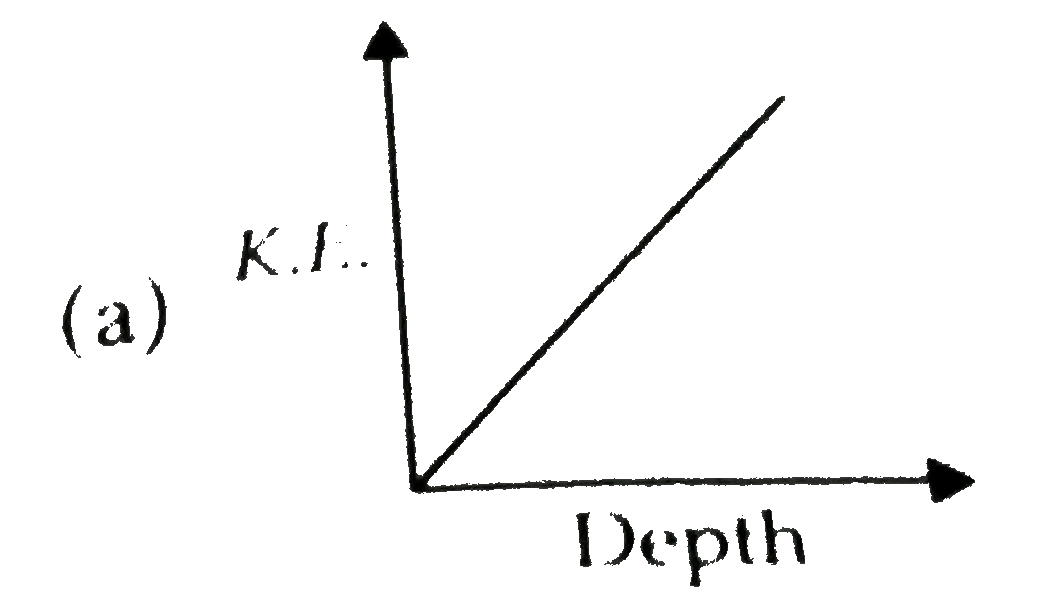A raindrop falling from a height h above ground, attains a near terminal velocity when it has fallen through a height (3/4)h. Which of the diagrams shown in figure correctly shows the change in kinetic and potential energy of the drop during its fall up to the ground ?




The correct Answer is:B
To solve the problem, we need to analyze the changes in kinetic energy (KE) and potential energy (PE) of a raindrop falling from a height h above the ground, particularly as it falls through a height of 34h and reaches near terminal velocity.
1. Identify Initial Conditions:
- At the height h (point C), the raindrop has maximum potential energy and zero kinetic energy.
- The potential energy (PE) at this point is given by:
PE=mgh
- The kinetic energy (KE) at this point is:
KE=0
2. Analyze the Fall to Height 34h:
- As the raindrop falls from height h to 34h (point B), it loses potential energy and gains kinetic energy.
- The potential energy at height 34h is:
PE=mg(34h)=34mgh
- The change in potential energy from point C to point B is:
ΔPE=PEinitial−PEfinal=mgh−34mgh=14mgh
- The kinetic energy at this point (point B) can be calculated using the work-energy principle. The work done on the raindrop is equal to the change in kinetic energy:
KEB=ΔPE=14mgh
3. Analyze the Fall to the Ground:
- As the raindrop continues to fall from height 34h to the ground (point A), it reaches near terminal velocity.
- At the ground (point A), the potential energy is zero:
PE=0
- The kinetic energy at this point (point A) is maximum and can be calculated as:
KEA=KEB+ΔPE=14mgh+34mgh=mgh
4. Summarize Energy Changes:
- From point C to point B:
- PE decreases from mgh to 34mgh
- KE increases from 0 to 14mgh
- From point B to point A:
- PE decreases from 34mgh to 0
- KE increases from 14mgh to mgh
5. Conclusion:
- The correct diagram will show a decrease in potential energy and an increase in kinetic energy. Initially, potential energy is high and kinetic energy is low, and as the drop falls, potential energy decreases while kinetic energy increases until it reaches the ground.
- At the height h (point C), the raindrop has maximum potential energy and zero kinetic energy.
- The potential energy (PE) at this point is given by:
PE=mgh
- The kinetic energy (KE) at this point is:
KE=0
- As the raindrop falls from height h to 34h (point B), it loses potential energy and gains kinetic energy.
- The potential energy at height 34h is:
PE=mg(34h)=34mgh
- The change in potential energy from point C to point B is:
ΔPE=PEinitial−PEfinal=mgh−34mgh=14mgh
- The kinetic energy at this point (point B) can be calculated using the work-energy principle. The work done on the raindrop is equal to the change in kinetic energy:
KEB=ΔPE=14mgh
- As the raindrop continues to fall from height 34h to the ground (point A), it reaches near terminal velocity.
- At the ground (point A), the potential energy is zero:
PE=0
- The kinetic energy at this point (point A) is maximum and can be calculated as:
KEA=KEB+ΔPE=14mgh+34mgh=mgh
- From point C to point B:
- PE decreases from mgh to 34mgh
- KE increases from 0 to 14mgh
- From point B to point A:
- PE decreases from 34mgh to 0
- KE increases from 14mgh to mgh
- The correct diagram will show a decrease in potential energy and an increase in kinetic energy. Initially, potential energy is high and kinetic energy is low, and as the drop falls, potential energy decreases while kinetic energy increases until it reaches the ground.
Topper's Solved these Questions
- WORK , ENERGY AND POWERBook:NCERT FINGERTPS ENGLISHChapter:WORK , ENERGY AND POWERExercise:ASSERTION & REASON
Explore 15 Videos
- WORK , ENERGY AND POWERBook:NCERT FINGERTPS ENGLISHChapter:WORK , ENERGY AND POWERExercise:Motion Of Work And Kinetic Energy : The Work-Energy Theorem
Explore 4 Videos
- WORK , ENERGY AND POWERBook:NCERT FINGERTPS ENGLISHChapter:WORK , ENERGY AND POWERExercise:Assertion And Reason
Explore 15 Videos
- WAVESBook:NCERT FINGERTPS ENGLISHChapter:WAVESExercise:Assertion And Reason
Explore 15 Videos
Similar Questions
Knowledge Check
Which of the diagrams in figure, correctly shows the change in kinetic energy of an iron sphere falling freely in a lake having sufficient depth to impart if a terminal velocity ?
A B
B C
C D
D
A ball of mass m is dropped from a cliff of height H. The ratio of its kinetic energy to the potential energy when it is fallen through a height 3/4 H is
A3:4B4:3C1:3D3:1A ball is dropped from a height h on the ground If the coefficient of restitution is e, the height to which the ball goes up after it rebounds for the nth time is
Ahe2nBhenCe2nhDhe2n
Which of the following graph is correct between kinetic energy E, potential energy (U) and height (h) from the ground of the partical
View SolutionA small drop of water falls from rest through a large height h in air, the final velocity is
View SolutionA body freely falling from the rest has velocity v after it falls through a height h the distance it has to fall down for its velocity to become double is
View SolutionA stone projected vertically upwards from the ground reaches a maximum height h. When it is at a height (3h)/(4), the ratio of its kinetic and potential energies is
View SolutionA raind drop starts falling from a heigh of 2km. If falls with a continuously decreasing acceleration and attains its terminal velocity at a height of 1km. The ratio of the work done by the gravitational force in the first halt to that in the second half of the drops journey is
View Solution

